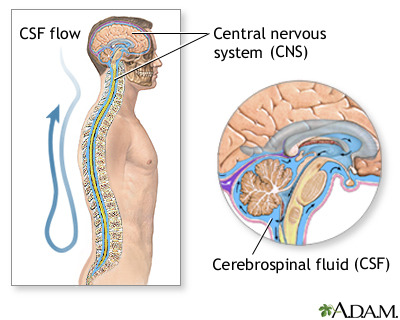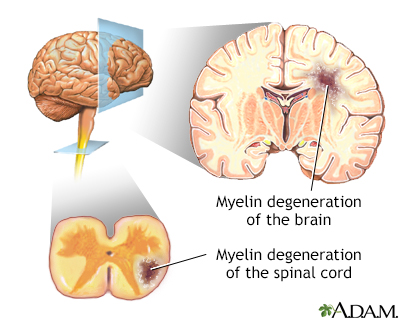CSF oligoclonal banding - series

Normal anatomy
The cerebrospinal fluid (CSF) serves to supply nutrients to the central nervous system (CNS) and collect waste products, as well as provide lubrication.

Indications
Why the test is performed.
This test helps confirm the diagnosis of multiple sclerosis (MS).
The laboratory procedure is called CSF electrophoresis, which is a method used to study the levels of protein in the cerebrospinal fluid (CSF).
In electrophoresis, a CSF sample is applied to a gel (solid medium allowing the movement of proteins), and a voltage is applied. The proteins migrate along the gel based on their charge (roughly on their size). The gel is stained, and significant amounts of similar proteins will cause a visible "band" to be present. The term oligoclonal bands refers the presence in CSF of two or more protein bands of a specific immunoglobin (IgG) that have greater intensity than in the concurrent serum sample. This pattern of banding is seen in patients with MS, and other conditions.

Procedure, part 1
A sample of the CSF will be taken from the lumbar area of the spine. This is called a lumbar puncture. How the test will feel: The position used during lumbar puncture may be uncomfortable, but you must remain in the curled position to avoid moving the needle and possibly injuring the spinal cord. There also may be some discomfort with the needle prick and the insertion of the lumbar puncture needle. When the fluid is withdrawn, there may be a feeling of pressure.
Risks of lumbar puncture include:
- Allergic reaction to the anesthetic.
- Discomfort during the test.
- Headache after the test.
- Bleeding into the spinal canal.
- Brain herniation (if performed on a patient with increased intracranial pressure), which can result in brain damage and/or death.
- Damage to the spinal cord (particularly ithe patient moves during the test).

Procedure, part 2
A blood sample will also be drawn.

Procedure, part 3
Both the samples are added to a gel, which is then filtered through a cartridge. The gel separates the proteins in each sample and the lab looks for oligoclonal banding.
If results are normal one or less bandings will be found in the CSF.
If results are abnormal there are 2 or more bandings found in the CSF and not in the blood serum. This may indicate multiple sclerosis (MS). CSF oligoclonal bands are found in 83% to 94% of patients with definite MS. Other causes of oligoclonal banding in CSF include encephalitis, meningitis, Guillain-Barre syndrome, polyneuritis, headache, and other conditions.
BACK TO TOP
Review Date: 4/29/2023
Reviewed By: Joseph V. Campellone, MD, Department of Neurology, Cooper Medical School of Rowan University, Camden, NJ. Review provided by VeriMed Healthcare Network. Also reviewed by David C. Dugdale, MD, Medical Director, Brenda Conaway, Editorial Director, and the A.D.A.M. Editorial team.

Health Content Provider
06/01/2025
|
A.D.A.M., Inc. is accredited by URAC, for Health Content Provider (www.urac.org). URAC's accreditation program is an independent audit to verify that A.D.A.M. follows rigorous standards of quality and accountability. A.D.A.M. is among the first to achieve this important distinction for online health information and services. Learn more about A.D.A.M.'s editorial policy, editorial process and privacy policy. A.D.A.M. is also a founding member of Hi-Ethics. This site complied with the HONcode standard for trustworthy health information from 1995 to 2022, after which HON (Health On the Net, a not-for-profit organization that promoted transparent and reliable health information online) was discontinued. |
The information provided herein should not be used during any medical emergency or for the diagnosis or treatment of any medical condition. A licensed medical professional should be consulted for diagnosis and treatment of any and all medical conditions. Links to other sites are provided for information only -- they do not constitute endorsements of those other sites. © 1997- 2024 A.D.A.M., a business unit of Ebix, Inc. Any duplication or distribution of the information contained herein is strictly prohibited.
